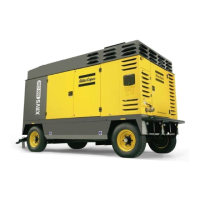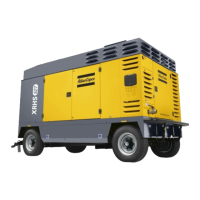Instruction Manual
12 2954 2510 03
1 Before towing the unit:
• ascertain that the pressure vessel(s) is (are) depressurized,
• check the towbar, the brake system and the towing eye. Also check the coupling of the
towing vehicle,
• check the towing and brake capability of the towing vehicle,
• check that the towbar, jockey wheel or stand leg is safely locked in the raised position,
• ascertain that the towing eye can swivel freely on the hook,
• check that the wheels are secure and that the tyres are in good condition and inflated
correctly,
• connect the signalisation cable, check all lights and connect the pneumatic brake couplers,
• attach the safety break-away cable or safety chain to the towing vehicle,
• remove wheel chocks, if applied, and disengage the parking brake.
2 To tow a unit use a towing vehicle of ample capacity. Refer to the documentation of the towing
vehicle.
3 If the unit is to be backed up by the towing vehicle, disengage the overrun brake mechanism (if
it is not an automatic mechanism).
4 Never exceed the maximum towing speed of the unit (mind the local regulations).
5 Place the unit on level ground and apply the parking brake before disconnecting the unit from
the towing vehicle. Unclip the safety break-away cable or safety chain. If the unit has no
parking brake or jockey wheel, immobilize the unit by placing chocks in front of and/or behind
the wheels. When the towbar can be positioned vertically, the locking device must be applied
and kept in good order.
6 To lift heavy parts, a hoist of ample capacity, tested and approved according to local safety
regulations, shall be used.
7 Lifting hooks, eyes, shackles, etc., shall never be bent and shall only have stress in line with
their design load axis. The capacity of a lifting device diminishes when the lifting force is applied
at an angle to its load axis.
8 For maximum safety and efficiency of the lifting apparatus all lifting members shall be applied as
near to perpendicular as possible. If required, a lifting beam shall be applied between hoist and
load.
9 Never leave a load hanging on a hoist.
10 A hoist has to be installed in such a way that the object will be lifted perpendicular. If that is not
possible, the necessary precautions must be taken to prevent load-swinging, e.g. by using two
hoists, each at approximately the same angle not exceeding 30° from the vertical.
11 Locate the unit away from walls. Take all precautions to ensure that hot air exhausted from the
engine and driven machine cooling systems cannot be recirculated. If such hot air is taken in by
the engine or driven machine cooling fan, this may cause overheating of the unit; if taken in for
combustion, the engine power will be reduced.
12 Before moving the compressor, switch it off.
13 If the warning light on the ABS module or in the vehicle lights up, please contact Atlas Copco.

